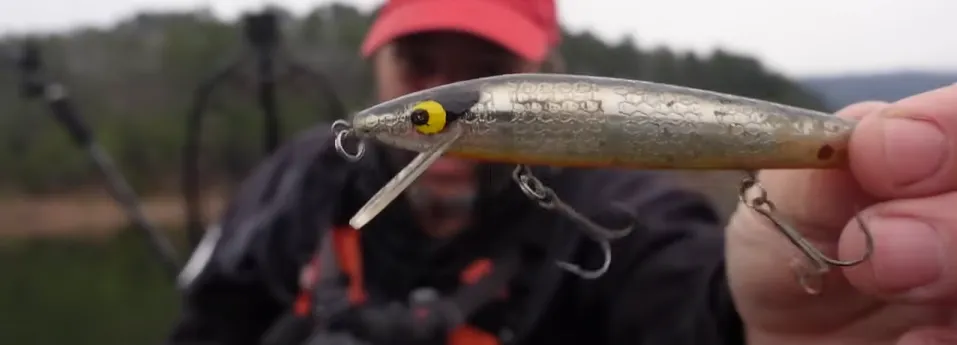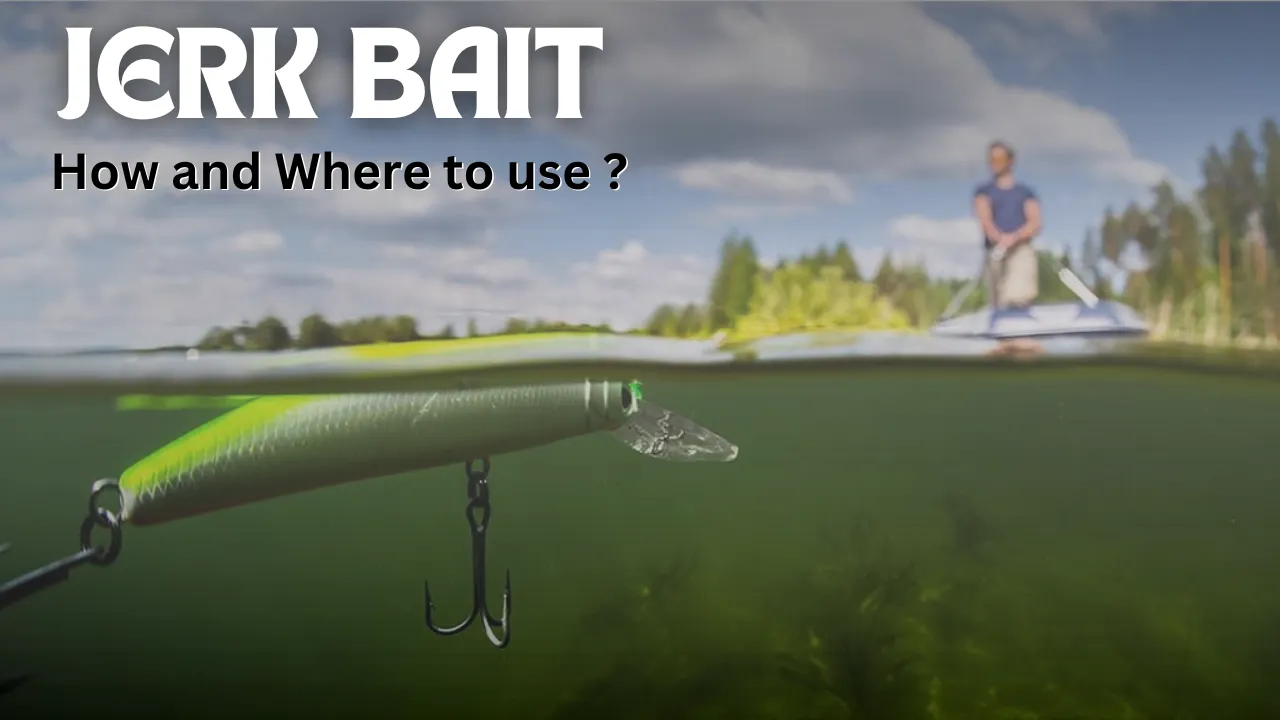The Comprehensive Guide to Mastering Jerkbait Fishing: Fishing continues to be an effective factor that enhances the probability of success for anglers afloat. This artificial lure is motionless and reputed to imitate a drowning baitfish, which is vital to attract carnivore fishes.
In general, jerkbait fishing can be beneficial for any person the beginner or the professional, consequently, it is important to know more about it. This guide will give you a comprehensive outlook on the principles of jerkbait fishing, the design and realization of this kind of bait, methods and tips which might be useful to increase the chances of a successful fishing session.

What is a Jerk Bait?
A jerk bait is a type of soft-bodied lure which imitates struggling or fleeing minnows or small fish. Mainly crafted using a hard plastic material, jerk baits have a slender body resembling an elongated form and, in most cases, have provisions for several treble hooks. T
he identification technique of jerk bait is that it is movable using the jerking action of the fishing rod and short, quick jiggling movements, which makes the bait move zigzag in water. This erratic action is designed to trigger predatory behavior among fish, and jerk baits are hence quite useful for the catching of fish such as bass, pike, and walleye.
What Makes Jerkbait Effective?
For jerkbaits, the goal is to make the lure look like a crippled or fleeing baitfish. One, fish appear pencil-like and very elongated, and second, they swim in a very unpredictable manner in the water, which serves to stimulate the fish-catching instincts of other fish. These snap baits are mainly made of hard plastic and include several treble hooks that boost your chances of hooking the fish. It can be noted that the major contribution of bullet points is not in their formulation but in their doing. This movement is created by jerks and worked perfectly to mimic the movements of the prey when effectively used.
Types of Jerkbaits and their Uses
Jerkbaits come in various shapes, sizes, and designs, each suited to different fishing conditions. Understanding these types and their specific applications can make a significant difference in your fishing success.

Suspending Jerkbaits:
These baits float on the water when in still water and when paused, looks like a bait that is hurt or tired. They do better in cool water or where fish are not very assertive. The way is to fish them with a slow and steady retrieve and keep the bait in the strike zone for a longer time.
Floating Jerkbaits: Built to float to the surface when no longer being retrieved, floating jerkbaits Therefore, are great for shallow-water and reactionary fish. This makes them able to float, thus giving them visibility and attractiveness in situations where the water is not deep.

Floating Jerkbaits:
Built to float to the surface when no longer being retrieved, floating jerkbaits Therefore, are great for shallow-water and reactionary fish. This makes them able to float, thus giving them visibility and attractiveness in situations where the water is not deep.

Diving Jerkbaits:
Each of these baits is constructed to dive to a certain depth and therefore handy for reaching different tiers of the water body. Using the depth level when throwing your jerkbait, you are in a position to mimic the feeding habits of the fish in different water column.
How to Rig a Jerk Bait
As for the rigging of the jerk bait, it is quite simple and, nevertheless, paying attention to the details is extremely helpful.
- Choose Your Line: Choose the right fishing line suitable for the jerk bait and the kind of fishing you are going to engage in. Fluorocarbon line is chosen for that; it is invisible and sensitive, while monofilament is chosen for its stretch and simplicity.
- Tie the Knot: Fold the hooks of the jerk bait upwards and then use a sturdy knot, either the improved clinch knot or the Palomar knot, to connect the jerk bait to the line. An important aspect is to ensure that the knot being used is tight because, when using, the bait can easily slip off.
- Attach the Jerk Bait: Thread the end of the line through a very small hole at the back part of the jerk bait. If the bait has multiple hooks, the line must pass through the correct eye of that hook.
- Check the Action: To do this, test the jerk bait when you are rigging it in the water so that you are sure it is working properly. In some cases, some fine tuning could be required if the bait does not swim how they want it to.

Effective Techniques for Using Jerkbait
Mastering jerkbait fishing involves more than just casting and retrieving. The technique is crucial and can vary based on water conditions and fish behavior. Here are some proven techniques to enhance your jerkbait fishing:
The Jerk and Pause Method:
This is the most common technique. Cast your jerkbait, then jerk the rod tip sharply to make the bait dart erratically. Follow this with a pause. The length of the pause can be adjusted based on how the fish are responding. Longer pauses can entice more hesitant fish, while shorter, quicker jerks can provoke aggressive strikes.
Rip and Stop Technique:
This technique involves making rapid, aggressive jerks followed by a brief stop. It can trigger reactions from fish that are actively hunting and prefer a more aggressive presentation.
Twitch and Retrieve:
This method involves twitching the rod tip in a subtle, rhythmic pattern. It creates a more subtle action that can be effective when fish are less active or in clearer waters where a more natural presentation is needed.
Choosing the Right Jerkbait for Conditions
When choosing the right jerkbait, consider elements such as water clarity, temperature, and depth. Here’s how to select the appropriate jerkbait for various conditions:
Water Clarity:
In clean water, choose natural colors and patterns that resemble local baitfish. To improve visibility in stained or murky water, choose brighter or more contrasting colors.
Cold water makes fish less active, so slower, more deliberate presentations with suspending jerkbaits can be productive. In warmer water, fish are more active, so faster retrieves with floating or diving jerkbaits are preferable.
Depth:
Adjust the depth of your jerkbait to match where the fish are feeding. For deeper water, use diving jerkbaits, while floating jerkbaits are best for shallow regions.
Gear and equipment for Jerkbait Fishing
The appropriate gear can significantly improve your jerkbait fishing experience. Here’s all you need:
Fishing Rod:
A medium to medium-heavy rod with a fast action tip works best for jerkbait fishing. This rod has the sensitivity to detect small bites and the power to perform sharp jerks.
Reel:
A reel with a high gear ratio enables for faster retrievals and more control over the bait’s motion. It is also useful for making precise throws and maintaining the line.
Line:
Use a monofilament or fluorocarbon line with a medium to high test strength. Fluorocarbon gives less visibility and higher sensitivity, whereas monofilament provides more flexibility and forgiving.
Practical Tips for Success
To maximize your success with jerkbait fishing, consider these practical tips:
Experiment with Speed and Action:
Fish behavior can change throughout the day, so be prepared to adjust your retrieve speed and action. Experiment with different techniques to find what works best.
Observe Water Conditions:
Pay attention to water temperature, clarity, and current. Adjust your bait and techniques accordingly to match the conditions.
Practice Patience:
Jerkbait fishing often requires patience. Be prepared to spend time working different areas and adjusting your techniques until you find what triggers the fish.
Techniques for Effective Jerkbait Fishing
To get the most out of jerk bait, understanding the proper technique is essential. Start by throwing the bait at the target area and this can easily be done with great accuracy. After the bait has been put in the water, begin shaking the water by fiercely moving the tip of the fishing rod. It should be accompanied by a short break, although not a complete standing still. The length of the delay varies depending on how the fish responds. A longer pause can persuade cautious fish to bite, whilst a faster retrieve may elicit a more aggressive strike.
Another element to consider is the depth at which the jerk bait operates. Jerk baits have varied shapes that allow them to float on the top or sink at varying depths. Deciding on the quantity of water to take depends on the feeding area depth of these fish. For instance, if you only intend on fishing at the deeper part of the lake, a better jerk bait to use will be the one that can dive to the required depth. A jerk bait that floats or runs on top of the water is much more suitable for fish that feed on items on the water surface.
Jerk baits come in a variety of types to suit different fishing conditions. Suspended jerk baits, for example, remain immobile when paused, giving the appearance of a motionless baitfish. This is especially effective in cold water or when the fish are not active. In contrast, floating jerk baits rise to the top during pauses, making them excellent for shallower areas or more aggressive fish.
Adapting to Conditions and Gear.
As a result, the application of jerk bait fishing requires an action to climatic factors such as water temperature, weather, and some seasons. When fish are in these cooler waters they don’t charge around like bait balls for fast moving baits and a slower, more lethargic approach may be best. If the water is warm then the fish is going to be more active and will respond to faster, more random patterns.
The rod and reel you use can also influence your success using jerk bait. A medium to medium-heavy rod with a fast-action tip is usually suggested. This rod has the sensitivity needed to detect small bites as well as the control required to execute sharp jerks. A reel with a high gear ratio can aid in speedier retrieve and more effective bait action.
How To Fish a Jerk Bait
Fishing with a jerk bait necessitates special tactics to ensure the bait behaves as intended:
Casting:
Use a smooth, accurate cast to get the jerk bait where you want it. Aim for regions where fish are likely to eat, such as near structures or drop-offs. After having placed the bait in the water, move the tip of the fishing rod in short, hard movements.
This motion should be accompanied by pause. The periods can vary depending on the reaction of the fish and the environment of the water. For example, a longer period will bring more careful fish in the water, but a shorter pause will trigger stronger attacks among the fish.
Experiment with different jerk speeds and pause lengths. Faster jerks can attract aggressive fish, although slower retrieves may be more effective in colder water or when fish are less active.
Watch for Bites:
Any variations in resistance or sudden tugging may indicate that a fish is striking. Set the hook firmly to achieve a secure connection.
When Should I Use a Jerk bait?
Jerk baits are versatile types of lures which might be used in numerous circumstances. However, they are particularly effective in the following situations:However, they are particularly effective in the following situations:
Clear Water:
In clear water fishing conditions, jerk baits are used because they do not swim in a uniform pattern; the movement will attract fish since natural baits cannot go unnoticed.
Cold Water:
Fish are not very active in cold water temperatures that are why jerk baits presents slow sositive movements. These are the Berkley PowerBait and the Gulp hollow belly floating baits and among them, suspended jerk baits are the most preferred.
Active Fish:
during the feeding period, especially during warm water, clingy and erratic movement a jerk bait presents is likely to trigger a strike.
Predatory Species:
Jerk baits are right on the spot when it comes to catching such fish as bass, pike and walleye because such fish species are very sensitive to movements and any form of vibration of the bait.
What is the Difference Between a Jerkbait and a Crankbait?
Whoppers and plugs are both categories of artificial baits but have varying sizes, and moving patterns.
Jerkbaits mimic dying baitfish and are retrieved slowly with sudden quick tugs of the fishing rod that causes the bait to move in a jerky fashion. Common designs for them are slim and tall, and they can hang, hover or drop. Plug style bait lures on the hand are relatively round at the tips and they are primarily built to deliver a perpetuating wobbling motion on the water when retrieved.
They rotate; open and close them to different extents depending on the size and position of the lips. Retrieve Techniques: Since jerkbaits imitate a lure that swims in front of the baitfish then these have to be jerked with some pause. Fishing with crankbaits is done slowly and the objects’ shaking and movement is the stimuli the fishes are attracted to.
Depth and Speed: Of the baits, jerkbaits can be used at different depth depending on the type of the bait. Berkley’s crankbaits are mainly made in a way that they dive to certain depths and have a consistent action on the retrieve.
Jerk Baits for Bass
Jerk baits are extremely useful for bass fishing because of their propensity to elicit forceful strikes. When targeting bass, consider the following tips:
Color and Pattern: Select jerk baits in colors and patterns that resemble local baitfish. Natural hues, such as shad or perch, are frequently effective in clear water, although brighter or more contrasting colors perform well in murky environments.
Size and Depth: Match the size of the jerk bait to the size of the bass you’re after and the depth at which they’re feeding. For larger bass, use larger jerk baits, and for deeper seas, choose diving jerk baits.
Technique: Test different retrieve speeds and pause lengths to see what the bass are responding to. Experiment with various actions to determine what causes the most strikes.
Understanding the nuances of jerk bait design, rigging, fishing techniques, and distinctions from other lures such as crankbaits will help you improve your fishing success and efficiently target species such as bass.
Summary about Jerk Baits
Altogether, jerk bait can be considered as one of the powerful and multifunctional techniques for fishers who want to enhance their results. Due to its design and the way that it operates, It can be used in various environments and for all sorts of fish species. Learning about jerk bait and the correct strategies, color patterns, equipment, and much more, will assist in increasing the standard of fishing and success rate in catching a fish. It is essential no matter whether you are a novice or an experienced fisherman to know about a few key factors related on the subject of boat fishing.

